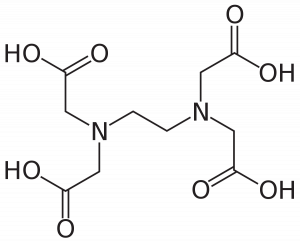Ethylenediamine Tetraacetic Acid is a Sequestering / Chelating Agent. EDTA is a synthetic amino acid. It is widely known as EDTA. It is a white powder. EDTA Acid is insoluble in water. It is also named as Ethylenediamine Tetraacetate. It is widely used to dissolve Metallic Impurities. There are various Salts / Derivatives of EDTA.
| CAS No. | 60-00-04. |
| HSN No. | 29173990. |
| Synonyms | Ethylenediaminetetraacetic Acid, N,N’-1,2-ethanediylbis(N-(carboxymethyl)glycine) edetic acid, Ethylenedinitrilotetracetate, Metaclaw, Trilon BS, Versene Acid, Dissolvine, Titriplex, etc. |
| Molecular Formula | C10H16N2O8 |
| Molecular Structure |  |
| Molecular Weight | 292.0. |
| Appearance | White Crystalline Powder. |
| Solubility | Insoluble In Water, Soluble in Alkalies. |
| Assay | 99.0% Min. |
| Chelation Value as mg. of CaCO3. | 330.0. |
| Packing | 25 Kg. HDPE Bags / Drums. |
EDTA is a Sequestering Agent, which is used in various Industries such as Pharmaceutical, Photography, Textile, Boiler Turbine scale removal, Agriculture as a Micronutrient for Plant Growth, Water Treatment, Laboratory Reagent, Food & Beverages, Cosmetics, Soaps & Detergents, etc. It is used for removing unwanted inorganic impurities present in the system, which helps in getting superior performance & cost saving.
EDTA is widely recognized as effective Sequestering Agent. EDTA grabs metallic cation such as Lead or Calcium from the process and forms a stable compound that is then excreted from the system. The stability of this bond is vital to get the success in removing the inorganic impurities out of the system. If the bond is weak, other chemicals can break this bond to form their own compounds.